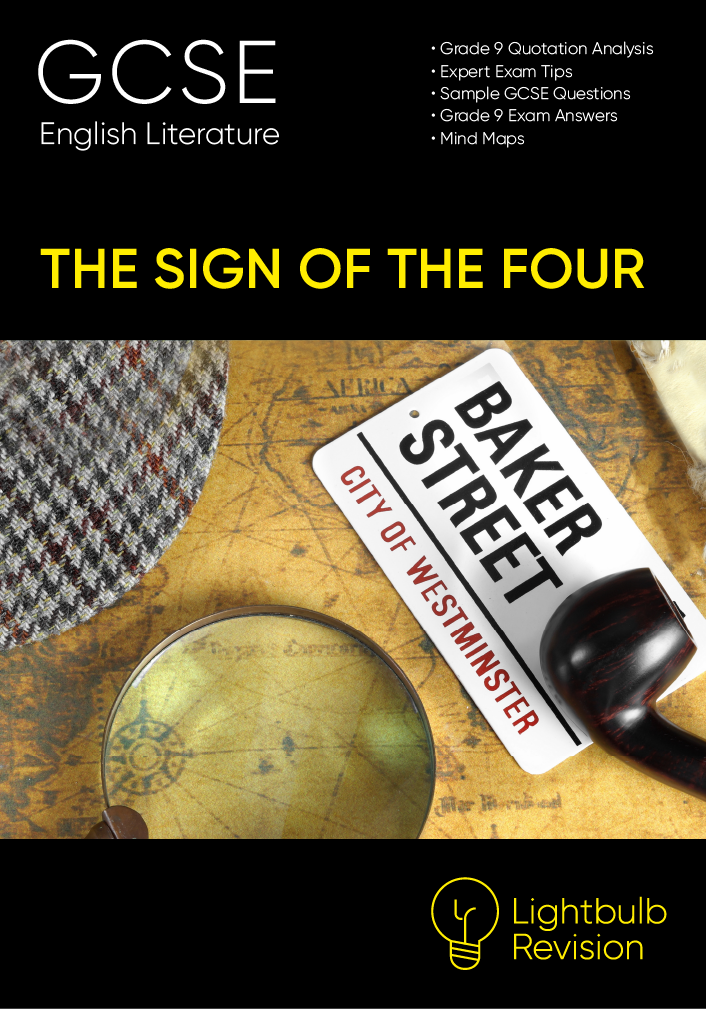Sherlock Holmes
Character Analysis
Sherlock Holmes is perhaps the most famous of fictional British detectives. His sharp intelligence and love of crime-solving make him an iconic (recognisable) figure who is so popular that the Sherlock Holmes canon (literary tradition) consists of over 50 short stories and four novels.
‘innumerable puncture marks’
• Holmes is introduced to us through the physical description of his drug use.
• Holmes is presented as someone who needs distraction from boredom. This could be perceived as a sign of his incredible intelligence or as a sign of weakness that he must seek distraction in drugs.
• Structurally, the story ends in the same place as it begins, with Holmes once again reaching for the cocaine bottle. It shows how he turns to drugs when the mental stimulation is ended- in this case, the mystery of the Sign of the Four is solved.
Context: Scientific experimentation during the Victorian era led to wide-spread use of drugs among the middle and upper classes. Many other 19th century authors such as Bronte, Dickens and Hardy show characters taking drugs; the modern reader is shocked by Holmes’ open drug use but in the context of the time, drug-taking was not only acceptable but was often seen to enhance creativity.
‘Give me problems, give me work’
• Holmes’ need for distraction is seen here as he states how he needs mental stimulation.
• The imperative verbs show his forceful nature as he demands challenges.
• There is a sense of an addict here. It’s almost as if he craves the intellectual stimulation like a drug.
• There could be a reference here to the theme of the duality of man; he is aware that without proper occupation, he might be tempted to other, shady activities. Work acts as a stimulant which keeps him from exploring his darker sides.
‘the amateur who fought three rounds’
• Holmes reminds Sholto’s porter that he is a good boxer, showing that he is a man of action as well as a man of great intellect.
Context: Conan Doyle enjoyed boxing and wrote a book about the sport. Conan Doyle used his own life and interests in the creation of his characters.
‘My dear doctor’ said he, kindly’
• Holmes apologises warmly to Watson after offending him with the casual analysis of Watson’s alcoholic brother’s watch.
• This endearment ‘my dear doctor’ is positive. The possessive pronoun ‘my’ captures the closeness between the two and the warmth of ‘dear’ shows that Holmes is capable of friendship.
• The adverb ‘kindly’ reveals a very compassionate, human quality in Holmes as he tries to soothe his friend’s upset feelings. This has the effect of humanising Holmes, who otherwise could seem as cold as a robot.
‘We MUST catch her!’ cried Holmes, between his teeth’
• Holmes is desperate to catch the Aurora, the boat on which Small and Tonga are escaping on.
• He is seen here as a man of passion and commitment; his tense excitement is clear in the exclamatory sentence and the observation that he is speaking through clenched teeth.
• Holmes uses the modal verb ‘must’ to create a desperate sense of urgency. This reveals his great desire to bring the criminals to justice and also serves to increase the dramatic tension of this scene.
‘excellent spirits… blackest depression’
• Holmes swings between opposite moods.
• The adjective ‘excellent’ suggests the very height of good temper while the superlative ‘blackest’ shows the depths of despair and misery. Clearly, the mood swings are extreme ones.
• The contrast in moods shows the duality of man: that we all have two sides to us.
Context: This idea of the duality of man fascinated the Victorians and the idea is explored in other contemporary novels, most notably Stevenson’s ‘Dr Jekyll and Mr Hyde’
‘Detection is… an exact science… should be treated in the cold, unemotional manner’
• Holmes speaks in a clinical, assured tone. The language of certainty ‘is’ ‘exact’ shows his precision which marks him as a man of science.
• Holmes’ cool, controlled speech contrasts with Watson’s much more emotional outbursts. The two men are often viewed as representing opposites: logic and rationality versus emotion.
• Holmes uses the modal verb ‘must’ to create a desperate sense of urgency. This reveals his great desire to bring the criminals to justice and also serves to increase the dramatic tension of this scene.
Context: The Victorian era saw the birth of forensic science: the solving of crime using science. Holmes’ attitude to detection reflects these new methods. There was a contemporary belief that men of science were naturally cold-blooded/cold-hearted with the logical side of them preventing the flow of emotions, and Holmes’ cool, detached manner fits in with this perception.

Grade 9 Analysis
Look at the character in a different way.
Does Holmes deserve to be liked and admired?
Yes: Conan Doyle ensures that we admire Holmes through his use of Watson, the friend who is also the narrator; Watson’s admiring observations of Holmes’ ‘great powers’, which are repeated to emphasise Holmes’ skills, directs the reader to also admire Holmes. Holmes is a multi-faceted character who we cannot help but like as well as admire. Not only is he highly intelligent but he is a good friend and shows kindness and mercy. Conan Doyle also constructs a likeable character by using situational humour to show Holmes’ sense of fun as he sits in the sailor’s disguise while Jones and Watson chat away obliviously. Holmes’ ‘quiet amusement’ at the trick reminds the reader that Holmes is witty as well as ferociously intelligent, and this warm side is reinforced by the sociable, ‘merry’ meal which he then shares with Watson and Jones.
No: The narrative shows his arrogance and a discerning reader will spot many errors in his seemingly infallible logic. An example of this is when he instructs Watson on the footprint; saying ‘the Hindoo proper has long and thin feet… the Mohammaden has the great toe…’ He uses language that is certain and authoritative yet it is completely unfounded in fact and promotes racial stereotypes. His cold, detached personality does not endear him to the reader.




